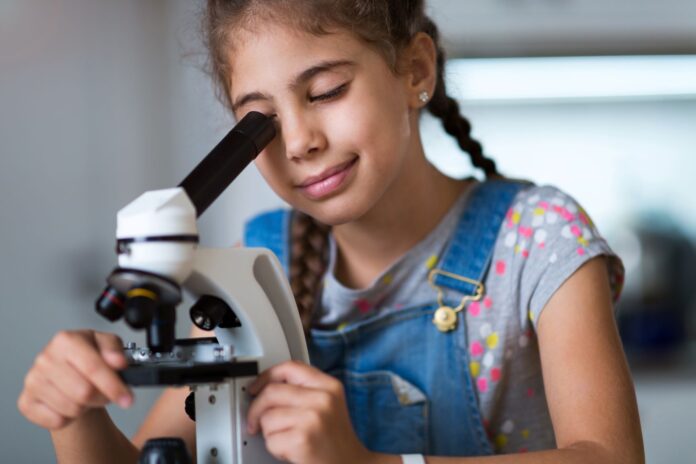Microscopes have been a great tool used by scientists to make significant discoveries over the centuries. It’s often assumed that children may lack the attention span and care needed to handle an instrument like a microscope. However, when children are encouraged to use the microscope—with the right teaching approach—it not only excites and engages them but can be used as an unparalleled introduction to science.
Admission Open 2023
- Top University & Colleges Official Links, Application & Scholarship Forms.
One of the best things about these instruments is that they are not only fun and interesting to play with, but also teach kids about the world. They can help them develop their sense of sight and encourage them to explore things in nature that interest them. Kids are naturally curious and love to see the world through different eyes. By using these devices, they can get the chance to do just that. In this article, we discuss how microscopes can encourage kids to be more enthusiastic about science later in life:
- Unparalleled Introduction to Science
Since children are curious by nature, the best way to introduce them to science is through experiential learning. This means introducing them to the plant and animal world by showing them what’s going on inside it through a microscope. For a simple introduction to science, you may take the children out in nature and ask them to collect plants, insects, or flowers that they may want to examine under a microscope. This will help build their interest in science in a natural way and outside of the classroom. If you’re planning to buy your child a microscope, check out the New York Microscope Company for good-quality microscopes for children.
Subscribe to Get Updated Information about How Microscopes Can Encourage Kids into Science Later in Life? - Admissions
- Enhances Their Exploratory Nature
When children are encouraged to use a microscope to explore things, it enhances their exploratory nature. As children start viewing distinct patterns and movements under the microscope, they’re likely to get inquisitive about how things work. This can lead to questioning and discussions and promotes active learning.
Learning about the properties of objects and how they work is something that many kids enjoy but is usually overlooked in classrooms. When children start enjoying their explorations, they can spend hours studying an object with great interest, without being told to study. This is a great way for them to learn about the world naturally.
As children get a chance to use a microscope as a hobby rather than reading science textbooks, it makes learning about science fun and exciting and enhances their cognitive abilities naturally. Check out the best microscopes for 10 year olds here.
If you think that your child could use a microscope to explore science, you may want to get them one. While they may not realize it at the time, this type of gift can benefit them for many years. There are several inexpensive microscopes available in the market that are perfect for children.
- Sparks Their Curiosity and Questioning
One of the thumb rules of learning is questioning and curiosity. When you stop asking questions, you’re not learning much. A child is naturally curious and is interested in knowing the world around them and are often questioning everything.
The one skill that’s important for science enthusiast is their ability to question things. When a child is given the opportunity to explore things under a microscope, it not only sparks their curiosity but naturally nudges them to ask questions.
Since science encourages questioning and curiosity, having these qualities from a young age will ensure that your children develop their interest in science spontaneously. A good way to help your child to develop their curiosity is to give them things of their interest like a flower or leaf to examine under a microscope or take them outdoors to watch the night sky using a microscope.
Conclusion

Microscopes can be great tools for introducing your children to science outside the setting of their classroom. Introducing them to science in this manner will nudge them to develop an interest in the subject naturally, through personal exploration and questioning. Using a microscope will also encourage the development of skills like curiosity, creativity, and explorative nature. Since these skills are essential for a science enthusiast, the natural development of them, through experiential learning, will ensure that their interest in science remains intact even when they grow older.
Having an interest in science can further help your child prepare for STEM learning. However, to take the first step towards exploratory learning, consider getting your child a microscope to explore the many mysteries of the world.
Microscopes can encourage kids into science later in life in a number of ways:
- They can spark curiosity and wonder. When kids use a microscope to see things that they can’t see with their naked eye, it can be a truly eye-opening experience. They may be amazed by the tiny creatures that live in a drop of water or the intricate structure of a leaf. This curiosity and wonder can lead to a lifelong interest in science.
- They can help kids develop critical thinking skills. Using a microscope requires kids to think about how things work and to make observations. They have to figure out how to focus the microscope, how to adjust the magnification, and how to interpret what they see. This process of critical thinking can help kids develop problem-solving skills that will be valuable in all areas of their lives.
- They can provide hands-on learning experiences. Learning about science in a textbook can be dry and boring. But when kids get to use a microscope, they are actively engaged in the learning process. They are able to see for themselves how things work, and this can make the learning experience much more memorable.
- They can help kids develop a love of learning. When kids have a positive experience with science, they are more likely to develop a love of learning. They are more likely to want to learn more about the world around them, and they are more likely to pursue science-related careers in the future.
In addition to these benefits, using a microscope can also help kids develop other important skills, such as:
- Fine motor skills. Using a microscope requires kids to use their hands and fingers in a precise way. This can help to improve their fine motor skills.
- Observation skills. Using a microscope requires kids to be able to observe things carefully and to make accurate observations. This can help to improve their observation skills.
- Communication skills. When kids use a microscope, they often have to share their observations with others. This can help to improve their communication skills.
Overall, using a microscope can be a great way to encourage kids into science later in life. It can spark curiosity, develop critical thinking skills, provide hands-on learning experiences, and help kids develop a love of learning. If you are looking for a way to encourage your child’s interest in science, consider giving them a microscope.
Here are some additional tips for encouraging kids into science with microscopes:
- Start with simple microscopes. There are many different types of microscopes available, so it is important to choose one that is appropriate for the age and skill level of the child. For younger children, a simple magnifying glass or a low-powered microscope may be a good option.
- Make it fun. Learning about science should be fun, so make sure that the child is enjoying the experience. You can do this by providing them with interesting objects to view under the microscope, such as plants, insects, or food. You can also make it a game by challenging them to find certain objects or features.
- Be patient. It may take some time for the child to get used to using a microscope. Be patient and offer them help and encouragement as needed.
- Talk about what they see. Once the child has had a chance to use the microscope, talk to them about what they see. Ask them questions about what they are looking at and help them to understand what they are seeing.
- Provide resources. There are many books, websites, and apps that can help kids learn about science. Provide the child with these resources so that they can continue their learning beyond the initial experience with the microscope.
















